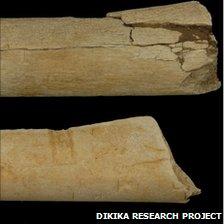Tool-making and meat-eating began 3.5 million years ago
- Published

The bones belonged to a goat-sized and a cow-sized animal
Researchers have found evidence that hominins - early human ancestors - used stone tools to cleave meat from animal bones more than 3.2 million years ago.
That pushes back the earliest known tool use and meat-eating in such hominins by more than 800,000 years.
Bones found in Ethiopia show cuts from stone and indications that the bones were forcibly broken to remove marrow.
The research, in the journal Nature, challenges several notions about our ancestors' behaviour.
Previously the oldest-known use of stone tools came from the nearby Gona region of Ethiopia, dating back to about 2.5 million years ago. That suggests that it was our more direct ancestors, members of our own genus Homo, that were the first to use tools.
But the marked bones were found in the Dikika region, with their age determined by dating the nearby volcanic rock - to between 3.2 million and 3.4 million years ago.
A battery of tests showed that the cuts, scrapes and scratches were made before the bones fossilised, and detailed analysis even showed that there were bits of stone lodged in one of the cuts.
In Lucy's hands
The only hominin species known from the Dikika region at that time was Australopithecus afarensis, the species represented by the famed "Lucy" fossil, and one that is hypothesised to be a direct ancestor of Homo and therefore of us.
But Lucy and her contemporaries were thought to be vegetarians, and many had assumed that tool use arose only in later, Homo species.

Study co-author Zeresenay Alemseged, the palaeoanthropologist from the California Academy of Sciences in San Francisco who leads a large research effort in the region, said that the find overturns much of what was thought about A. afarensis.
"For 30 years, no-one has been able to put stone tools in their hands, and we've done that for the first time," he told BBC News.
"We are showing for the first time that stone tool use is not unique to Homo or Homo-related species - we have A. afarensis now behaving like Homo in a way both by using tools and eating meat. It's another attribute that could enable us to link A. afarensis to the genus Homo."
The conclusions, however, are based on a small number of bones, and the inference of stone tool use is made indirectly: no tools were actually found at the site. That means it remains unclear if A. afarensis actually made the tools from larger bits of stone, or simply used sharpened fragments that were found.
'Big story'
Both Alemseged and Shannon McPherron, an archaeologist from the Max Planck Institute of Evolutionary Anthropology in Leipzig, Germany, and lead author of the study, say that the next task is to return to the region and keep looking for evidence to tie up the story.
They hope to establish that it was in fact A. afarensis that used the tools, rather than any other species that has not yet been found in the region.

Analysis showed the cuts were definitely made by stone, not scavengers
"It's always hard to associate a behaviour with a particular hominin," Dr McPherron explained to BBC News.
"We're never so lucky as to find a hominin dead with the archaeology in its hand."
But more than that, the team want to look for tools and any potential evidence of their manufacture, to find what kind of tools the A. afarensis butcher actually had.
The previous record-holders for oldest stone tools seemed relatively advanced, Dr McPherron explained, so experts have guessed for some time that less sophisticated tools would be found.
"What we can now think about is a fairly extended period of time when these hominins were experimenting with stone, perhaps using naturally occurring flakes," he said.
"But at some point they would've started to make their own. What we need to do is fill in that time period."
Chris Stringer of the Natural History Museum in London cautions against making firm conclusions about the development of tool use, given the limited number of artifacts from the current find.
"We have to be cautious that these are just a couple of bones with what seem to be cut marks on them; one would like to have stone tools associated with them to really clinch the case," he told BBC News.
However, he agrees that pushing the first known date of tool use back by nearly a million years is, regardless, "a big story".
"It suggests that meat-eating and butchery behaviour is pre-human - it's an ancestral behaviour and as such it gives an interesting perspective on the Australopithecines that we didn't have before," he said.
"They seemed to be vegetarian and lacking significant aspects of human behaviour, and in a sense this would bring them somewhat closer to us."